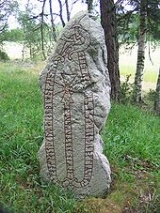
England Runestones
Encyclopedia
The England runestones (Swedish
: Englandsstenarna) is a group of about 30 runestones that refer to Viking Age
voyages to England
. They constitute one of the largest groups of runestones that mention voyages to other countries, and they are comparable in number only to the approximately 30 Greece Runestones
and the 26 Ingvar Runestones
, of which the latter refer to a Viking expedition to the Middle East. They were engraved in Old Norse
with the Younger Futhark
.
The Anglo-Saxon rulers paid large sums, Danegeld
s, to Vikings, who mostly came from Denmark
and who arrived to the English shores during the 990s and the first decades of the 11th century. Some runestones relate of these Danegelds, such as the Yttergärde runestone, U 344, which tells of Ulf of Borresta
who received the danegeld three times, and the last one he received from Canute the Great
. Canute sent home most of the Vikings who had helped him conquer England, but he kept a strong bodyguard, the Þingalið
, and its members are also mentioned on several runestones.
The vast majority of the runestones, 27, were raised in modern-day Sweden
and 17 in the oldest Swedish provinces around lake Mälaren
. In contrast, modern-day Denmark
has no such runestones, but there is a Danish runestone in Scania
that mentions London
. There is also a runestone in Norway
and a Swedish one in Schleswig, Germany
.
Some Vikings, such as Guðvér did not only attack England, but also Saxony
, as reported by the Grinda Runestone Sö 166 in Södermanland:
Below follows a presentation of the England Runestones based on information collected from the Rundata
project, organized according to location. The transcriptions
from runic inscriptions into standardized Old Norse
are in the Swedish
and Danish
dialect to facilitate comparison with the inscriptions, while the English translation provided by Rundata give the names in standard dialect (the Icelandic
and Norwegian
dialect).
that mention voyages to England. Several of them were raised in memory of men who had partaken in the Danegeld
in England.
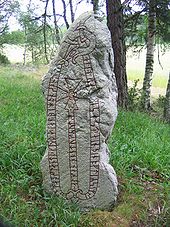 This secluded runestone is located in a grove near Väsby, Uppland
This secluded runestone is located in a grove near Väsby, Uppland
, Sweden
. It was raised by a Viking in commemoration of his receiving one danegeld in England. It is classified as being carved in runestone style
Pr3 and, together with U 344, it has been said to be the earliest example of an Urnes style
inscription in Uppland. The runic text follows a common rule to only carve a single rune for two consecutive letters, even when the letters were at the end of one word and the beginning of a second word. When the text shown as Latin characters, the transliterated runes are doubled and separate words are shown. For U 194 has three examples where this occurred, þinoftiR is transliterated as þino| |oftiR, tuknuts as tuk| |knuts, and anklanti as a| |anklanti.
Latin transliteration:
Old Norse transcription:
English translation:
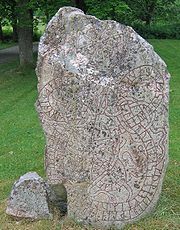
This runestone is one of the Lingsberg Runestones
and was part of a paired monument with U 240. It is located on the courtyard of the estate Lingsberg in Uppland. It was raised by the grandchildren of Ulfríkr in commemoration of his receiving two danegelds in England. It is carved in runestone style Pr3.
Latin transliteration:
Old Norse transcription:
English translation:
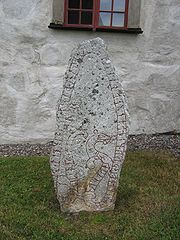 The runestone U 344, in the style Pr3, was found in 1868, at Yttergärde, by Richard Dybeck
The runestone U 344, in the style Pr3, was found in 1868, at Yttergärde, by Richard Dybeck
, but it is today raised at the church of Orkesta, see Orkesta Runestones
. Together with U 194, it is considered to be the earliest example of the Urnes style in Uppland.
The runes are written from right to left with the orientation of the runes going in the same direction, but the last words outside the runic band have the usual left-right orientation. It can be dated to the first half of the 11th century because of its use of the ansuz rune
for the a and æ phomenes, and because of its lack of dotted runes.
This stone is notable because it commemorates that the Viking
Ulf of Borresta
had taken three danegelds in England. The first one was with Skagul Toste
in 991, the second one with Thorkel the High in 1012 and the last one with Canute the Great
in 1018. Since there were many years between the danegelds, it is likely that Ulfr returned to Sweden after each danegeld to live as a wealthy magnate.
Latin transliteration:
Old Norse transcription:
English translation:
 This runestone is located at the church of Husby-Sjuhundra. It is one of the older runestones as it is in the style RAK. It is raised in memory of Sveinn who intended to go to England but died on route in Jutland
This runestone is located at the church of Husby-Sjuhundra. It is one of the older runestones as it is in the style RAK. It is raised in memory of Sveinn who intended to go to England but died on route in Jutland
. Omeljan Pritsak
comments that Sveinn probably died in the Limfjord
, Jutland, as the fjord was usually the starting point for campaigns against England. Jansson dates Svein's death to 1015, when Canute the Great
's great invasion fleet had been assembled in the Limfjord, a fleet that had many young warriors from Uppland. When the fleet departed for England, Sveinn was no longer aboard.
The hope that God and God's mother would treat the man better than he deserved is an expression that appears on several runestones, and it is not understood as an expression of his having a bad character but it is a request that he should be favoured in the afterlife.
Latin transliteration:
Old Norse transcription:
English translation:
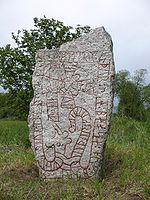 This runestone is located at Tång, and it is raised in memory of a man who died in battle in England. It is classified as being carved in runestone style Pr1, but the runemaster
This runestone is located at Tång, and it is raised in memory of a man who died in battle in England. It is classified as being carved in runestone style Pr1, but the runemaster
is considered to have had little experience in the craft. The runic text contains a bind rune
, which is a ligature combining two runes, for an a-rune and a l-rune
, which may have been done simply to save space.
Latin transliteration:
Old Norse transcription:
English translation:
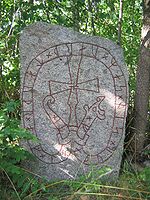 This runestone is carved in runestone style Pr2 and was raised at the church of Hjälsta. It was raised in memory of a man's father who died in England. Based on its size and runic text, it has been suggested that U 812 was once part of a coupled monument located in a cemetery, but that the runestone with the first half of the overall text has been lost. Other pairs of runestones that may have formed a coupled monument in a cemetery are U 49 and U 50 in Lovö and Sö Fv1948;282 and Sö 134 in Ludgo.
This runestone is carved in runestone style Pr2 and was raised at the church of Hjälsta. It was raised in memory of a man's father who died in England. Based on its size and runic text, it has been suggested that U 812 was once part of a coupled monument located in a cemetery, but that the runestone with the first half of the overall text has been lost. Other pairs of runestones that may have formed a coupled monument in a cemetery are U 49 and U 50 in Lovö and Sö Fv1948;282 and Sö 134 in Ludgo.
Latin transliteration:
Old Norse transcription:
English translation:
 This stone is located in the wall of the church of Gamla Uppsala
This stone is located in the wall of the church of Gamla Uppsala
. It is carved in runestone style Pr2 and made of sandstone. It was made by a man who called himself "traveller to England" in memory of his father.
Latin transliteration:
Old Norse transcription:
English translation:
 This fragmented runestone is classified as being carved in runestone style Fp and is located at Lilla Runhällen. It was raised by a man who had travelled to England in memory of himself.
This fragmented runestone is classified as being carved in runestone style Fp and is located at Lilla Runhällen. It was raised by a man who had travelled to England in memory of himself.
Latin transliteration:
Old Norse transcription:
English translation:
 This runestone was found in Hormesta, and it is one of the older runestones as it is classified as being carved in runestone style RAK, which is considered to be the oldest style. It is raised by two men in memory of their brother who died in England.
This runestone was found in Hormesta, and it is one of the older runestones as it is classified as being carved in runestone style RAK, which is considered to be the oldest style. It is raised by two men in memory of their brother who died in England.
Latin transliteration:
Old Norse transcription:
English translation:
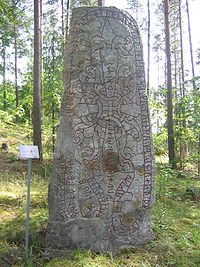 This runestone in Bjudby was raised by a man in memory of his son Hefnir who went to England and back, and instead of having a warrior's death overseas, he died at home. Due to the use of the ansuz rune
This runestone in Bjudby was raised by a man in memory of his son Hefnir who went to England and back, and instead of having a warrior's death overseas, he died at home. Due to the use of the ansuz rune
for the o phoneme, Erik Brate argues that Hefnir participated in a late 11th century expedition to England. He suggests that Hefnir was part of the invasion force sent to England by Sweyn Estridsson, in 1069, and which was intended to defeat William the Conqueror's Normans. The invasion had been planned for two years, but William the conqueror bought off the commander of the force who was Sweyn Estridsson's brother Asbjörn. The inscription is in runestone style Pr2 and was carved by two runemaster
s whose names are normalized
as Slode and Brune. Brune's signature is also on Sö 178
at Gripsholm Castle
.
Latin transliteration:
Old Norse transcription:
English translation:
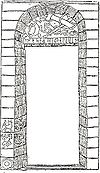 This runestone has disappeared but it was located at the church of Tumbo. It is classified as possibly being in runestone style Pr4. The inscription has been attributed based on stylistic analysis to the runemaster Näsbjörn, and what little remained of the stone when it was discovered said that a man drowned in England.
This runestone has disappeared but it was located at the church of Tumbo. It is classified as possibly being in runestone style Pr4. The inscription has been attributed based on stylistic analysis to the runemaster Näsbjörn, and what little remained of the stone when it was discovered said that a man drowned in England.
Latin transliteration:
Old Norse transcription:
English translation:
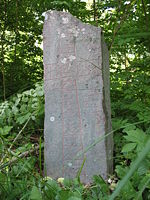 This runestone is located at the church of Råby. Like the Kolsta Runestone, it is raised in memory of a man who died in the assembly retinue (þingalið
This runestone is located at the church of Råby. Like the Kolsta Runestone, it is raised in memory of a man who died in the assembly retinue (þingalið
) in England.
Latin transliteration:
Old Norse transcription:
English translation:
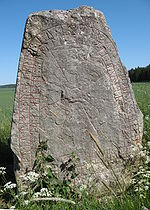 This runestone which is located in Grinda is in the style RAK. It is raised in memory of a father who divided up gold in England and attacked some towns in northern Germany. According to Omeljan Pritsak
This runestone which is located in Grinda is in the style RAK. It is raised in memory of a father who divided up gold in England and attacked some towns in northern Germany. According to Omeljan Pritsak
, the gold which was divided was part of the danegeld
, and Erik Brate argues that it was the same expedition as the one mentioned on the Berga Runestone.
Latin transliteration:
Old Norse transcription:
English translation:
Latin transliteration:
Old Norse transcription:
English translation:
 This runestone is located in the garden of the farm Vändle and it is tentatively categorized as being carved in runestone style Fp. It is raised in memory of a man who travelled to England.
This runestone is located in the garden of the farm Vändle and it is tentatively categorized as being carved in runestone style Fp. It is raised in memory of a man who travelled to England.
Latin transliteration:
Old Norse transcription:
English translation:
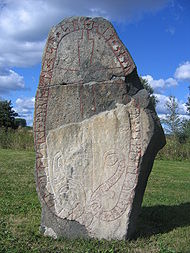 This runestone is located near the bridge of Saltängsbron and it is in the style Pr3. It is in memory of a man who died in England.
This runestone is located near the bridge of Saltängsbron and it is in the style Pr3. It is in memory of a man who died in England.
Latin transliteration:
× kisl × lit × kera × buru × eftR × osl × sun × sin × han u(a)[rþ] × tyþr × a eklati × kuþ ialbi × has × ont auk × selu
Old Norse transcription:
English translation:
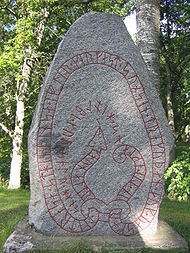 This runestone is located in Berga and is classified as being carved in runestone style Fp. It was carved by the same runemaster
This runestone is located in Berga and is classified as being carved in runestone style Fp. It was carved by the same runemaster
as the Ingvar runestone Vs 19. Similar to the inscription on U 194, the runic text has an example where a single rune was used for two consecutive letters with one at the end of one word and the other at the start of a second word. The runemaster on both Vs 18 and Vs 19 used the same runes trekuþan which were transliterated to show two letters and separate words as trek| |kuþan. Vs 18 and Vs 19 were also sponsored by the same person, Gunnvaldr.
Latin transliteration:
Old Norse transcription:
English translation:
 This is a fragment that remains of a runestone. It was found in 1927 in Västra Hästbo near the church of Torsåker, and today it is almost hidden behind a pillar inside the church. It is in sandstone and it is one of the older runestones as it is carved in runestone style RAK. This the classification for inscriptions with runic band ends which do not have any attached serpent or beast heads. The runic text indicates that it was raised in memory of a man who went to England. The last word has a bind rune that combines a k-rune
This is a fragment that remains of a runestone. It was found in 1927 in Västra Hästbo near the church of Torsåker, and today it is almost hidden behind a pillar inside the church. It is in sandstone and it is one of the older runestones as it is carved in runestone style RAK. This the classification for inscriptions with runic band ends which do not have any attached serpent or beast heads. The runic text indicates that it was raised in memory of a man who went to England. The last word has a bind rune that combines a k-rune
and u-rune
, but it has been suggested that this was done to correct an error made when carving the text.
Latin transliteration:
Old Norse transcription:
English translation:
, there are two runestones that mention men who travelled to England, and both men died there.
Latin transliteration:
Old Norse transcription:
English translation:
. The stone is in greyish red granite and it is 3.95 m tall (2.98 above soil) and 1.43 m wide, and the surface is quite weathered. The name Vígfastr is otherwise unattested on runestones and also the name Helga was quite rare. It is carved in runestone style Fp.
The Rundata
designation for this Östergötland inscription, Ög Fv1950;341, refers to the year and page number of the issue of Fornvännen
in which the runestone was first described.
Latin transliteration:
Old Norse transcription:
English translation:
, there are five or six runestones that mention voyages to England. One of them (Sm 77) mentions a man who was a marshal (stallari) in England.
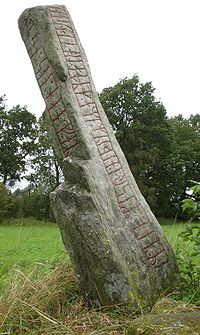 This runestone is located in Transjö. It is one of the older stones as it is in the style RAK. The runes are unusual as the m-runes are dotted (
This runestone is located in Transjö. It is one of the older stones as it is in the style RAK. The runes are unusual as the m-runes are dotted ( ) and the k-runes
) and the k-runes
have a stroke to the left instead of to the right. It is raised in memory of a son who died in England.
Latin transliteration:
Old Norse transcription:
English translation:
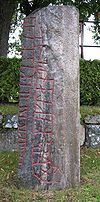 This runestone is raised on the cemetery of the church of Berga. It is classified as being in runestone style RAK and it is consequently one of the older runestones. It is raised in memory of a man who died in England.
This runestone is raised on the cemetery of the church of Berga. It is classified as being in runestone style RAK and it is consequently one of the older runestones. It is raised in memory of a man who died in England.
Latin transliteration:
Old Norse transcription:
English translation:
 This runestone is located in Ingelstad. It is carved in runestone style RAK and is consequently one of the older runestones. It was raised in memory of a father who died in England.
This runestone is located in Ingelstad. It is carved in runestone style RAK and is consequently one of the older runestones. It was raised in memory of a father who died in England.
Latin transliteration:
Old Norse transcription:
English translation:
 This runestone is located in Sävsjö, and it is raised by Vrái in memory of a brother who died in England. Later, Vrái would also receive a memorial, the nearby Komstad Runestone which tells that Vrái had been the marshall (stallari) of an earl Hakon, who was probably the earl Håkon Eiriksson
This runestone is located in Sävsjö, and it is raised by Vrái in memory of a brother who died in England. Later, Vrái would also receive a memorial, the nearby Komstad Runestone which tells that Vrái had been the marshall (stallari) of an earl Hakon, who was probably the earl Håkon Eiriksson
.
Latin transliteration:
Old Norse transcription:
English translation:
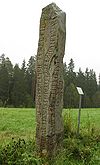 The Nävelsjö runestone is located at the estate of Nöbbelesholm, and it is raised in memory of a father who died in England and was buried by his brother in Bath, Somerset.
The Nävelsjö runestone is located at the estate of Nöbbelesholm, and it is raised in memory of a father who died in England and was buried by his brother in Bath, Somerset.
Latin transliteration:
Old Norse transcription:
English translation:
 This fragment of a runestone is located in the atrium of the church of Vetlanda and what remains appears to say "in the west in England."
This fragment of a runestone is located in the atrium of the church of Vetlanda and what remains appears to say "in the west in England."
Latin transliteration:
Old Norse transcription:
English translation:
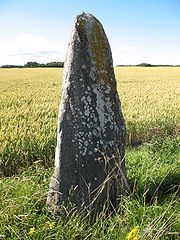 This runestone is located in Västanåker and is classified as being carved in runestone style RAK. It was raised as a memorial to a son who died in England.
This runestone is located in Västanåker and is classified as being carved in runestone style RAK. It was raised as a memorial to a son who died in England.
Latin transliteration:
Old Norse transcription:
English translation:
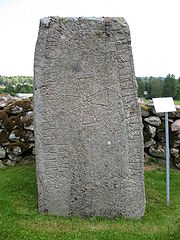 This runestone is located at the church of Vist. It is carved in runestone style RAK and it is thus one of the older runestones. It was raised in memory of a brother who died in England.
This runestone is located at the church of Vist. It is carved in runestone style RAK and it is thus one of the older runestones. It was raised in memory of a brother who died in England.
Latin transliteration:
Old Norse transcription:
English translation:
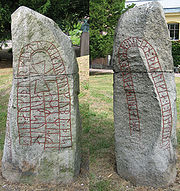 This runestone is located in Valleberga at "runestone hill" in Lund
This runestone is located in Valleberga at "runestone hill" in Lund
. It is one of the older runestones as it is classified as being carved in runestone style RAK.
Latin transliteration:
Old Norse transcription:
English translation:
 This runestone is located in Schleswig Cathedral
This runestone is located in Schleswig Cathedral
. The ornamentation shows that it was made by a Swede. It was made in memory of a man who lay dead in a location called Skía in Old Norse in England. According to Omeljan Pritsak
, Skía was probably Shoebury
in Essex
or Skidby
in Yorkshire
.
Latin transliteration:
Old Norse transcription:
English translation:
. It is an older runestone as it is classified as being in runestone style RAK. It was raised in memory of a son who died in service with the army of Canute the Great
when he attacked England.
Latin transliteration:
Old Norse transcription:
English translation:
Swedish language
Swedish is a North Germanic language, spoken by approximately 10 million people, predominantly in Sweden and parts of Finland, especially along its coast and on the Åland islands. It is largely mutually intelligible with Norwegian and Danish...
: Englandsstenarna) is a group of about 30 runestones that refer to Viking Age
Viking Age
Viking Age is the term for the period in European history, especially Northern European and Scandinavian history, spanning the late 8th to 11th centuries. Scandinavian Vikings explored Europe by its oceans and rivers through trade and warfare. The Vikings also reached Iceland, Greenland,...
voyages to England
England
England is a country that is part of the United Kingdom. It shares land borders with Scotland to the north and Wales to the west; the Irish Sea is to the north west, the Celtic Sea to the south west, with the North Sea to the east and the English Channel to the south separating it from continental...
. They constitute one of the largest groups of runestones that mention voyages to other countries, and they are comparable in number only to the approximately 30 Greece Runestones
Greece Runestones
The Greece runestones are about 30 runestones containing information related to voyages made by Norsemen to the Eastern Roman Empire. They were made during the Viking Age until about 1100 and were engraved in the Old Norse language with Scandinavian runes...
and the 26 Ingvar Runestones
Ingvar Runestones
The Ingvar Runestones is the name of c. 26 Varangian Runestones that were raised in commemoration of those who died in the Swedish Viking expedition to the Caspian Sea of Ingvar the Far-Travelled....
, of which the latter refer to a Viking expedition to the Middle East. They were engraved in Old Norse
Old Norse
Old Norse is a North Germanic language that was spoken by inhabitants of Scandinavia and inhabitants of their overseas settlements during the Viking Age, until about 1300....
with the Younger Futhark
Younger Futhark
The Younger Futhark, also called Scandinavian runes, is a runic alphabet, a reduced form of the Elder Futhark, consisting of only 16 characters, in use from ca. 800 CE...
.
The Anglo-Saxon rulers paid large sums, Danegeld
Danegeld
The Danegeld was a tax raised to pay tribute to the Viking raiders to save a land from being ravaged. It was called the geld or gafol in eleventh-century sources; the term Danegeld did not appear until the early twelfth century...
s, to Vikings, who mostly came from Denmark
Denmark
Denmark is a Scandinavian country in Northern Europe. The countries of Denmark and Greenland, as well as the Faroe Islands, constitute the Kingdom of Denmark . It is the southernmost of the Nordic countries, southwest of Sweden and south of Norway, and bordered to the south by Germany. Denmark...
and who arrived to the English shores during the 990s and the first decades of the 11th century. Some runestones relate of these Danegelds, such as the Yttergärde runestone, U 344, which tells of Ulf of Borresta
Ulf of Borresta
Ulf of Borresta was not only a runemaster in eleventh century Uppland, Sweden, but also a successful Viking who returned from England three times with a share of the Danegeld...
who received the danegeld three times, and the last one he received from Canute the Great
Canute the Great
Cnut the Great , also known as Canute, was a king of Denmark, England, Norway and parts of Sweden. Though after the death of his heirs within a decade of his own and the Norman conquest of England in 1066, his legacy was largely lost to history, historian Norman F...
. Canute sent home most of the Vikings who had helped him conquer England, but he kept a strong bodyguard, the Þingalið
Þingalið
The Thingmen was a standing army in the service of the Kings of England during the period 1013-51, financed by direct taxation which had its origins in the tribute known as Danegeld....
, and its members are also mentioned on several runestones.
The vast majority of the runestones, 27, were raised in modern-day Sweden
Sweden
Sweden , officially the Kingdom of Sweden , is a Nordic country on the Scandinavian Peninsula in Northern Europe. Sweden borders with Norway and Finland and is connected to Denmark by a bridge-tunnel across the Öresund....
and 17 in the oldest Swedish provinces around lake Mälaren
Mälaren
Lake Mälaren is the third-largest lake in Sweden, after Lakes Vänern and Vättern. Its area is 1,140 km² and its greatest depth is 64 m. Mälaren spans 120 kilometers from east to west...
. In contrast, modern-day Denmark
Denmark
Denmark is a Scandinavian country in Northern Europe. The countries of Denmark and Greenland, as well as the Faroe Islands, constitute the Kingdom of Denmark . It is the southernmost of the Nordic countries, southwest of Sweden and south of Norway, and bordered to the south by Germany. Denmark...
has no such runestones, but there is a Danish runestone in Scania
Scania
Scania is the southernmost of the 25 traditional non-administrative provinces of Sweden, constituting a peninsula on the southern tip of the Scandinavian peninsula, and some adjacent islands. The modern administrative subdivision Skåne County is almost, but not totally, congruent with the...
that mentions London
London
London is the capital city of :England and the :United Kingdom, the largest metropolitan area in the United Kingdom, and the largest urban zone in the European Union by most measures. Located on the River Thames, London has been a major settlement for two millennia, its history going back to its...
. There is also a runestone in Norway
Norway
Norway , officially the Kingdom of Norway, is a Nordic unitary constitutional monarchy whose territory comprises the western portion of the Scandinavian Peninsula, Jan Mayen, and the Arctic archipelago of Svalbard and Bouvet Island. Norway has a total area of and a population of about 4.9 million...
and a Swedish one in Schleswig, Germany
Germany
Germany , officially the Federal Republic of Germany , is a federal parliamentary republic in Europe. The country consists of 16 states while the capital and largest city is Berlin. Germany covers an area of 357,021 km2 and has a largely temperate seasonal climate...
.
Some Vikings, such as Guðvér did not only attack England, but also Saxony
Saxony
The Free State of Saxony is a landlocked state of Germany, contingent with Brandenburg, Saxony Anhalt, Thuringia, Bavaria, the Czech Republic and Poland. It is the tenth-largest German state in area, with of Germany's sixteen states....
, as reported by the Grinda Runestone Sö 166 in Södermanland:
|
Below follows a presentation of the England Runestones based on information collected from the Rundata
Rundata
The Scandinavian Runic-text Data Base is a project involving the creation and maintenance of a database of runic inscriptions. The project's goal is to comprehensively catalog runestones in a machine-readable way for future research...
project, organized according to location. The transcriptions
Runic transliteration and transcription
Runic transliteration and transcription are part of analysing a runic inscription which involves transliteration of the runes into Latin letters, transcription into a normalized spelling in the language of the inscription, and translation of the inscription into a modern language...
from runic inscriptions into standardized Old Norse
Old Norse
Old Norse is a North Germanic language that was spoken by inhabitants of Scandinavia and inhabitants of their overseas settlements during the Viking Age, until about 1300....
are in the Swedish
Swedish language
Swedish is a North Germanic language, spoken by approximately 10 million people, predominantly in Sweden and parts of Finland, especially along its coast and on the Åland islands. It is largely mutually intelligible with Norwegian and Danish...
and Danish
Danish language
Danish is a North Germanic language spoken by around six million people, principally in the country of Denmark. It is also spoken by 50,000 Germans of Danish ethnicity in the northern parts of Schleswig-Holstein, Germany, where it holds the status of minority language...
dialect to facilitate comparison with the inscriptions, while the English translation provided by Rundata give the names in standard dialect (the Icelandic
Icelandic language
Icelandic is a North Germanic language, the main language of Iceland. Its closest relative is Faroese.Icelandic is an Indo-European language belonging to the North Germanic or Nordic branch of the Germanic languages. Historically, it was the westernmost of the Indo-European languages prior to the...
and Norwegian
Norwegian language
Norwegian is a North Germanic language spoken primarily in Norway, where it is the official language. Together with Swedish and Danish, Norwegian forms a continuum of more or less mutually intelligible local and regional variants .These Scandinavian languages together with the Faroese language...
dialect).
Uppland
There are eight runestones in UpplandUppland
Uppland is a historical province or landskap on the eastern coast of Sweden, just north of Stockholm, the capital. It borders Södermanland, Västmanland and Gästrikland. It is also bounded by lake Mälaren and the Baltic sea...
that mention voyages to England. Several of them were raised in memory of men who had partaken in the Danegeld
Danegeld
The Danegeld was a tax raised to pay tribute to the Viking raiders to save a land from being ravaged. It was called the geld or gafol in eleventh-century sources; the term Danegeld did not appear until the early twelfth century...
in England.
U 194

Uppland
Uppland is a historical province or landskap on the eastern coast of Sweden, just north of Stockholm, the capital. It borders Södermanland, Västmanland and Gästrikland. It is also bounded by lake Mälaren and the Baltic sea...
, Sweden
Sweden
Sweden , officially the Kingdom of Sweden , is a Nordic country on the Scandinavian Peninsula in Northern Europe. Sweden borders with Norway and Finland and is connected to Denmark by a bridge-tunnel across the Öresund....
. It was raised by a Viking in commemoration of his receiving one danegeld in England. It is classified as being carved in runestone style
Runestone styles
The runestone styles varied during the Viking Age. The early runestones were simple in design, but towards the end of the runestone era they became increasingly complex and made by travelling runemasters such as Öpir and Visäte....
Pr3 and, together with U 344, it has been said to be the earliest example of an Urnes style
Urnes style
The Urnes style was the last phase of Scandinavian animal art during the second half of the 11th century and in the early 12th century. The preceding phases of Scandinavia's Viking Age animal ornamentation are usually categorized as Oseberg style, Borre style, Jelling style, Mammen style and...
inscription in Uppland. The runic text follows a common rule to only carve a single rune for two consecutive letters, even when the letters were at the end of one word and the beginning of a second word. When the text shown as Latin characters, the transliterated runes are doubled and separate words are shown. For U 194 has three examples where this occurred, þinoftiR is transliterated as þino| |oftiR, tuknuts as tuk| |knuts, and anklanti as a| |anklanti.
Latin transliteration:
- al|i| |l|it raisa stain þino| |oftiR sik sialfan ' hon tuk| |knuts kialt a| |anklanti ' kuþ hialbi hons ant
Old Norse transcription:
- Ali/Alli let ræisa stæin þenna æftiR sik sialfan. Hann tok Knuts giald a Ænglandi. Guð hialpi hans and.
English translation:
- "Áli/Alli had this stone raised in memory of himself. He took Knútr's payment in England. May God help his spirit."
U 241

This runestone is one of the Lingsberg Runestones
Lingsberg Runestones
The Lingsberg Runestones are two 11th century runestones, listed as U 240 and U 241 in the Rundata catalog, and one fragment, U 242, that are engraved in Old Norse using the younger futhark and located at the farm at Lingsberg, which is about two kilometers northeast of Vallentuna, Stockholm...
and was part of a paired monument with U 240. It is located on the courtyard of the estate Lingsberg in Uppland. It was raised by the grandchildren of Ulfríkr in commemoration of his receiving two danegelds in England. It is carved in runestone style Pr3.
Latin transliteration:
- n tan auk huskarl ' auk sua(i)n ' l(i)tu rita stin aftiR ' ulfrik ' faþurfaþur sino ' hon hafþi o| |onklanti tuh kialt| |takit + kuþ hialbi þiRa kiþka salu| |uk| |kuþs muþ(i)
Old Norse transcription:
- En Dan ok Huskarl ok Svæinn letu retta stæin æftiR Ulfrik, faðurfaður sinn. Hann hafði a Ænglandi tu giald takit. Guð hialpi þæiRa fæðga salu ok Guðs moðiR.
English translation:
- "And Danr and Húskarl and Sveinn had the stone erected in memory of Ulfríkr, their father's father. He had taken two payments in England. May God and God's mother help the souls of the father and son."
U 344

Richard Dybeck
Richard Dybeck was a Swedish jurist, antiquarian and lyricist, mainly remembered as the author of the lyrics to what is now the Swedish national anthem: Du gamla, Du fria....
, but it is today raised at the church of Orkesta, see Orkesta Runestones
Orkesta Runestones
The Orkesta Runestones are 11th century runestones engraved in Old Norse with the younger futhark that are located at the church of Orkesta north-east of Stockholm in Sweden....
. Together with U 194, it is considered to be the earliest example of the Urnes style in Uppland.
The runes are written from right to left with the orientation of the runes going in the same direction, but the last words outside the runic band have the usual left-right orientation. It can be dated to the first half of the 11th century because of its use of the ansuz rune
Ansuz rune
The a-rune , Younger Futhark was probably called *ansuz in Proto-Germanic, to which the Norse name Æsir is attributed.The shape of the rune is likely from Neo-Etruscan a , like Latin A ultimately from Phoenician aleph....
for the a and æ phomenes, and because of its lack of dotted runes.
This stone is notable because it commemorates that the Viking
Viking
The term Viking is customarily used to refer to the Norse explorers, warriors, merchants, and pirates who raided, traded, explored and settled in wide areas of Europe, Asia and the North Atlantic islands from the late 8th to the mid-11th century.These Norsemen used their famed longships to...
Ulf of Borresta
Ulf of Borresta
Ulf of Borresta was not only a runemaster in eleventh century Uppland, Sweden, but also a successful Viking who returned from England three times with a share of the Danegeld...
had taken three danegelds in England. The first one was with Skagul Toste
Skagul Toste
Skoglar Toste or Skoglar Tosti was a chieftain from the Swedish province of West Götaland. According to Snorri Sturluson, he was the father of Sigrid the Haughty. For some time he gave refuge to Harald Grenske, who later came back to woo Sigrid, only to be killed by her for his persistence...
in 991, the second one with Thorkel the High in 1012 and the last one with Canute the Great
Canute the Great
Cnut the Great , also known as Canute, was a king of Denmark, England, Norway and parts of Sweden. Though after the death of his heirs within a decade of his own and the Norman conquest of England in 1066, his legacy was largely lost to history, historian Norman F...
in 1018. Since there were many years between the danegelds, it is likely that Ulfr returned to Sweden after each danegeld to live as a wealthy magnate.
Latin transliteration:
- in ulfr hafiR o| |onklati ' þru kialt| |takat þit uas fursta þis tusti ka-t ' þ(a) ---- (þ)urktil ' þa kalt knutr
Old Norse transcription:
- En UlfR hafiR a Ænglandi þry giald takit. Þet vas fyrsta þet's Tosti ga[l]t. Þa [galt] Þorkætill. Þa galt Knutr.
English translation:
- "And Ulfr has taken three payments in England. That was the first that Tosti paid. Then Þorketill paid. Then Knútr paid."
U 539

Jutland
Jutland , historically also called Cimbria, is the name of the peninsula that juts out in Northern Europe toward the rest of Scandinavia, forming the mainland part of Denmark. It has the North Sea to its west, Kattegat and Skagerrak to its north, the Baltic Sea to its east, and the Danish–German...
. Omeljan Pritsak
Omeljan Pritsak
Omeljan Pritsak was the first Mykhailo Hrushevsky Professor of Ukrainian History at Harvard University and the founder and first director of the Harvard Ukrainian Research Institute.-Career:Pritsak began his academic career at the University of Lvov in interwar Poland where he...
comments that Sveinn probably died in the Limfjord
Limfjord
The Limfjord is a shallow sound in Denmark that separates the island of Vendsyssel-Thy from the rest of the Jutland Peninsula. It extends from Thyborøn Channel on the North Sea to Hals on the Kattegat. It is approximately 180 kilometres long and of an irregular shape with several bays, narrowings,...
, Jutland, as the fjord was usually the starting point for campaigns against England. Jansson dates Svein's death to 1015, when Canute the Great
Canute the Great
Cnut the Great , also known as Canute, was a king of Denmark, England, Norway and parts of Sweden. Though after the death of his heirs within a decade of his own and the Norman conquest of England in 1066, his legacy was largely lost to history, historian Norman F...
's great invasion fleet had been assembled in the Limfjord, a fleet that had many young warriors from Uppland. When the fleet departed for England, Sveinn was no longer aboard.
The hope that God and God's mother would treat the man better than he deserved is an expression that appears on several runestones, and it is not understood as an expression of his having a bad character but it is a request that he should be favoured in the afterlife.
Latin transliteration:
- A tiarfR × uki × urika × uk ' uiki × uk × iukiR × uk × kiRialmR × þiR bryþr × aliR × litu × risa ×
- B stin þina × iftiR × suin × bruþur × sin × saR × uarþ × tuþr a × iut(l)ati × on skulti
- C fara × til × iklanþs × kuþ × ialbi × (o)ns × at uk salu × uk| ×| kus muþiR × betr × þan an karþi til
Old Norse transcription:
- A DiarfR ok Orøkia ok Vigi ok IogæiRR ok GæiRhialmR, þæiR brøðr alliR letu ræisa
- B stæin þenna æftiR Svæin, broður sinn. SaR varð dauðr a Iutlandi. Hann skuldi
- C fara til Ænglands. Guð hialpi hans and ok salu ok Guðs moðiR bætr þan hann gærði til.
English translation:
- A "Djarfr and Órœkja and Vígi and Jógeirr and Geirhjalmr, all of these brothers had"
- B "this stone raised in memory of Sveinn, their brother. He died in Jútland. He meant to"
- C "travel to England. May God and God's mother help his spirit and soul better than he deserved."
U 616

Runemaster
A runemaster or runecarver is a specialist in making runestones.Most early medieval Scandinavians were probably literate in runes, and most people probably carved messages on pieces of bone and wood. However, it was difficult to make runestones, and in order to master it one also needed to be a...
is considered to have had little experience in the craft. The runic text contains a bind rune
Bind rune
A bind rune is a ligature of two or more runes. They are extremely rare in Viking Age inscriptions, but are common in pre-Viking Age and in post-Viking Age inscriptions....
, which is a ligature combining two runes, for an a-rune and a l-rune
Laguz
*Laguz or *Laukaz is the reconstructed Proto-Germanic name of the l-rune , *laguz meaning "water" or "lake" and *laukaz meaning "leek". In the Anglo-Saxon rune poem, it is called lagu "ocean". In the Younger Futhark, the rune is called lögr "waterfall" in Icelandic and logr "water" in Norse.The...
, which may have been done simply to save space.
Latin transliteration:
- fir--(r)iui : lit rita * kuml : yfitiRr : fnþur : sih : baosa : auk : boruþur : kuru- * kuþ hi=a=l-... * ul kuru -ial uti * a| |akla--
Old Norse transcription:
-
let retta kuml æfti faður sinn Bosa(?)/Bausa(?) ok broður . Guð hial[pi] [f]ioll uti a Ængla[ndi].
English translation:
- "
had the monument erected in memory of his father Bósi(?)/Bausi(?) and (his) brother . May God help fell abroad in England."
U 812

Latin transliteration:
- × faþur × sin × saR × uarþ × tauþr × o eg×loti ×
Old Norse transcription:
- faður sinn. SaR varð dauðr a Ænglandi.
English translation:
- "his father. He died in England."
U 978

Gamla Uppsala
Gamla Uppsala is a parish and a village outside Uppsala in Sweden. It had 16,231 inhabitants in 1991.As early as the 3rd century AD and the 4th century AD and onwards, it was an important religious, economic and political centre...
. It is carved in runestone style Pr2 and made of sandstone. It was made by a man who called himself "traveller to England" in memory of his father.
Latin transliteration:
- sihuiþr ...-i + stain + þina + iklats+fari + iftir + uitarf + faþ(u)(r) [+ -... ...sia]... ...ku---
Old Norse transcription:
- Sigviðr [ræist]i stæin þenna Ænglandsfari æftiR Vidiarf, faður ... ... ...
English translation:
- "Sigviðr, traveller to England, raised this stone in memory of Védjarfr, (his) father ... ... ..."
U 1181

Latin transliteration:
- ...-(i) × lit × (a)kua ... ...[k × sa](l)fan × ek-...ns*fari ' a(f)i × kunu-s *
Old Norse transcription:
- ... let haggva ... [si]k sialfan, Æng[la]ndsfari, afi
.
English translation:
- "... had (the stone) cut ... (in memory of) himself, traveller to England, grandfather of
."
Södermanland
There are six known runestones in Södermanland that mention men who had travelled to England.Sö 46

Latin transliteration:
- iskil : auk : knauþimanr : raistu : stain : þansi : at : bruþur : sin : suera : as : uarþ : tauþr * o * eklanti kuml * kiarþu : þatsi : [kitil slakR]
Old Norse transcription:
- Æskell ok Gnauðimandr(?) ræistu stæin þannsi at broður sinn Sværra(?), es varð dauðr a Ænglandi. Kumbl giærðu þatsi Kætill [ok] StakkR.
English translation:
- "Áskell and Gnauðimaðr(?) raised this stone in memory of their brother Sverri(?), who died in England. Ketill and Stakkr made this monument."
Sö 55

Ansuz rune
The a-rune , Younger Futhark was probably called *ansuz in Proto-Germanic, to which the Norse name Æsir is attributed.The shape of the rune is likely from Neo-Etruscan a , like Latin A ultimately from Phoenician aleph....
for the o phoneme, Erik Brate argues that Hefnir participated in a late 11th century expedition to England. He suggests that Hefnir was part of the invasion force sent to England by Sweyn Estridsson, in 1069, and which was intended to defeat William the Conqueror's Normans. The invasion had been planned for two years, but William the conqueror bought off the commander of the force who was Sweyn Estridsson's brother Asbjörn. The inscription is in runestone style Pr2 and was carved by two runemaster
Runemaster
A runemaster or runecarver is a specialist in making runestones.Most early medieval Scandinavians were probably literate in runes, and most people probably carved messages on pieces of bone and wood. However, it was difficult to make runestones, and in order to master it one also needed to be a...
s whose names are normalized
Old Norse orthography
The orthography of the Old Norse language was diverse, being written in both Runic and Latin alphabets, with many spelling conventions, variant letterforms, and unique letters and signs. In modern times, scholars established a standardized spelling for the language. When Old Norse names are used in...
as Slode and Brune. Brune's signature is also on Sö 178
Södermanland Runic Inscription 178
Södermanland Runic Inscription 178 or Sö 178 is the Rundata catalog number for a Viking Age memorial runestone which is located at Gripsholm Castle, Södermanland County, Sweden, which is in the historic province of Södermanland.-Description:...
at Gripsholm Castle
Gripsholm Castle
Gripsholm Castle is a castle in Mariefred, Södermanland, in Sweden and is regarded as one of Sweden's finest historical monuments. It is located by lake Mälaren in south central Sweden, in the municipality of Strängnäs, about 60 km west of Stockholm....
.
Latin transliteration:
- þorstain (l)(i)... ...sa : stain : þena : ... sik : sialfan : auk : sun : sin : hefni : uaR til : enklans : ukr : trenkr : farin : uarþ : þa * haima : at : harmi tauþr kuþ hialbi : sialu : þaima bruni : auk : sloþi : þaiR ...(u) stan þena
Old Norse transcription:
- Þorstæinn le[t ræi]sa stæin þenna [æftiR] sik sialfan ok sun sinn Hæfni. VaR til Ænglands ungR drængR farinn, varð þa hæima at harmi dauðr. Guð hialpi sialu þæiRa. Bruni ok Sloði þæiR [rist]u stæin þenna.
English translation:
- "Þorsteinn had this stone raised in memory of himself and his son Hefnir. The young valiant man travelled to England; then died grievously at home. May God help their souls. Brúni and Slóði, they carved this stone."
Sö 83

Latin transliteration:
- [...an : truknaþi : i eklans : han...]
Old Norse transcription:
- [H]ann drunknaði i Ænglands ...
English translation:
- "He drowned in England's ..."
Sö 160

Þingalið
The Thingmen was a standing army in the service of the Kings of England during the period 1013-51, financed by direct taxation which had its origins in the tribute known as Danegeld....
) in England.
Latin transliteration:
-
: aybirn : raisþi : stain : þansi : at : karþi : han uarþ : tauþr : o| |oklati i liþi
Old Norse transcription:
- Øybiorn ræisþi stæin þannsi at Skærði. Hann varð dauðr a Ænglandi i liði.
English translation:
- "Eybjôrn raised this stone in memory of Skerðir. He died in the retinue in England."
Sö 166

Omeljan Pritsak
Omeljan Pritsak was the first Mykhailo Hrushevsky Professor of Ukrainian History at Harvard University and the founder and first director of the Harvard Ukrainian Research Institute.-Career:Pritsak began his academic career at the University of Lvov in interwar Poland where he...
, the gold which was divided was part of the danegeld
Danegeld
The Danegeld was a tax raised to pay tribute to the Viking raiders to save a land from being ravaged. It was called the geld or gafol in eleventh-century sources; the term Danegeld did not appear until the early twelfth century...
, and Erik Brate argues that it was the same expedition as the one mentioned on the Berga Runestone.
Latin transliteration:
-
: kriutkarþr : ainriþi : suniR : kiarþu : at : faþur : snialan : kuþuiR : uaR uastr : a : aklati : kialti : skifti : burkiR : a : sahks:lanti : suti : kaula
Old Norse transcription:
- Griutgarðr, Æinriði, syniR, giærðu at faður sniallan. GuðveR vaR vestr a Ænglandi, gialdi skifti, borgiR a Saxlandi sotti karla.
English translation:
- "Grjótgarðr (and) Einriði, the sons made (the stone) in memory of (their) able father. Guðvér was in the west; divided (up) payment in England; manfully attacked townships in Saxony."
Sö 207
This runestone is located at the church of Överselö. It is made of sandstone and carved in runestone style Fp. It is in memory of a father who travelled to England.Latin transliteration:
- kuþr... ... (f)aþur sin * fur * hfila * hn * til * iklans * kuþ halbi * sil hns
Old Norse transcription:
- Guð... ... faður sinn. For hæfila hann til Ænglands. Guð hialpi sal hans.
English translation:
- "Guð-... ... his father. He competently travelled to England. May God help his soul."
Vs 5

Latin transliteration:
- [kra-hni- × lit × resa × s... ...] + uas × farin + til + ekla-s [× (t)u i × sbelbuþa × --s(a)þu × helb]i × kuþ [× se... ... ... sigi * iuk × -u...]
Old Norse transcription:
-
let ræisa s[tæin] ... vas farinn til Ængla[nd]s. Do i Spiallbuða ... Hialpi Guð se[lu hans] ... Siggi hiogg [r]u[naR].
English translation:
- "
had the stone raised ... travelled to England, died in Spjallboði's ... May God help his soul ... Siggi cut the runes."
Vs 9

Latin transliteration:
× kisl × lit × kera × buru × eftR × osl × sun × sin × han u(a)[rþ] × tyþr × a eklati × kuþ ialbi × has × ont auk × selu
Old Norse transcription:
- Gisl let gærva bro æftiR Asl/Ôsl, sun sinn. Hann varð dauðr a Ænglandi. Guð hialpi hans and ok selu.
English translation:
- "Gísl had the bridge made in memory of Ásl/Ôsl, his son. He died in England. May God help his spirit and soul."
Vs 18

Runemaster
A runemaster or runecarver is a specialist in making runestones.Most early medieval Scandinavians were probably literate in runes, and most people probably carved messages on pieces of bone and wood. However, it was difficult to make runestones, and in order to master it one also needed to be a...
as the Ingvar runestone Vs 19. Similar to the inscription on U 194, the runic text has an example where a single rune was used for two consecutive letters with one at the end of one word and the other at the start of a second word. The runemaster on both Vs 18 and Vs 19 used the same runes trekuþan which were transliterated to show two letters and separate words as trek| |kuþan. Vs 18 and Vs 19 were also sponsored by the same person, Gunnvaldr.
Latin transliteration:
- (k)hunaltr * liet resa * sthin * þensa * iftir * kerfast * sun sen * trek| |kuþan * auk * uas farin * til eklans * hiolbi * kuþ * salu * hans
Old Norse transcription:
- Gunnaldr let ræisa stæin þennsa æftiR GæiRfast, sun sinn, dræng goðan, ok vas farinn til Ænglands. Hialpi Guð salu hans.
English translation:
- "Gunnvaldr had this stone raised in memory of Geirfastr, his son, a good valiant man. And (he) had travelled to England. May God help his soul."
Gs 8

Kaunan
The k-rune is called Kaun in both the Norwegian and Icelandic rune poems, meaning "ulcer". The reconstructed Proto-Germanic name is *Kaunan. It is also known as Kenaz , based on its Anglo-Saxon name.The Elder Futhark shape is likely directly based on Old Italic c / Latin C...
and u-rune
Ur (rune)
The reconstructed Proto-Germanic name of the Elder Futhark u rune is *Ūruz meaning "wild ox" or *Ûram "water". It may have been derived from the Raetic alphabet character u as it is similar in both shape and sound value...
, but it has been suggested that this was done to correct an error made when carving the text.
Latin transliteration:
- asmuntr -... ...faþ-... han : uas : uist : --- ikla-ti ...k=uust--
Old Norse transcription:
- Asmundr ... ... Hann vas vestr [ut a] Ængla[n]di ...
English translation:
- "Ásmundr ... ... He was abroad in the west in England ..."
Östergötland
In ÖstergötlandÖstergötland
Östergötland, English exonym: East Gothland, is one of the traditional provinces of Sweden in the south of Sweden. It borders Småland, Västergötland, Närke, Södermanland, and the Baltic Sea. In older English literature, one might also encounter the Latinized version, Ostrogothia...
, there are two runestones that mention men who travelled to England, and both men died there.
Ög 104
This runestone is located in Gillberga. It is in the style Fp and it is raised in memory of a brother who died in England. The stone is located near an ancient road and was raised to its current position in 1866.Latin transliteration:
-
: ruþr : risti : stin : þinsi : iftiR : tuk- : bruþur : sin : saR : uarþ : trbin : a : ilati : triR : arþa : kuþr :
Old Norse transcription:
- Rauðr ræisti stæin þennsi æftiR Tok[a], broður sinn, saR varð drepinn a Ænglandi, drængR harða goðr.
English translation:
- "Rauðr raised this stone in memory of Tóki, his brother, a very good valiant man, who was killed in England."
Ög Fv1950;341
This runestone is dated to around 1025, and it was raised in memory of a father who died in England. It was discovered in 1950 lying with the text downwards on the property of the farm Kallerstad, only 200 metres from Ög 113. It was probably found in its original location since a road used to pass the stone. The stone had been broken into two pieces, but was reassembled and raised outside of the county museum of LinköpingLinköping
Linköping is a city in southern middle Sweden, with 104 232 inhabitants in 2010. It is the seat of Linköping Municipality with 146 736 inhabitants and the capital of Östergötland County...
. The stone is in greyish red granite and it is 3.95 m tall (2.98 above soil) and 1.43 m wide, and the surface is quite weathered. The name Vígfastr is otherwise unattested on runestones and also the name Helga was quite rare. It is carved in runestone style Fp.
The Rundata
Rundata
The Scandinavian Runic-text Data Base is a project involving the creation and maintenance of a database of runic inscriptions. The project's goal is to comprehensively catalog runestones in a machine-readable way for future research...
designation for this Östergötland inscription, Ög Fv1950;341, refers to the year and page number of the issue of Fornvännen
Fornvännen
Fornvännen is a Swedish academic journal in the fields of archaeology and Medieval art. It is published quarterly by the Royal Swedish Academy of Letters in Stockholm, Sweden. The journal's contributions are written in the Scandinavian languages, English, or German with summaries in English...
in which the runestone was first described.
Latin transliteration:
- ...-iur- : auk : as-iurn : þiR : ristu : stin : þasi : eft-R : uikfast : faþur : sin : es uas : tuþr : o : eklati : sun : helgu
Old Norse transcription:
- ...[b]ior[n] ok As[b]iorn þæiR ræistu stæin þasi æft[i]R Vigfast, faður sinn, es vas dauðr a Ænglandi, sun Hælgu.
English translation:
- "...-bjôrn and Ásbjôrn, they raised this stone in memory of Vígfastr, their father, Helga's son. He died in England."
Småland
In SmålandSmåland
' is a historical province in southern Sweden.Småland borders Blekinge, Scania or Skåne, Halland, Västergötland, Östergötland and the island Öland in the Baltic Sea. The name Småland literally means Small Lands. . The latinized form Smolandia has been used in other languages...
, there are five or six runestones that mention voyages to England. One of them (Sm 77) mentions a man who was a marshal (stallari) in England.
Sm 5

 ) and the k-runes
) and the k-runesKaunan
The k-rune is called Kaun in both the Norwegian and Icelandic rune poems, meaning "ulcer". The reconstructed Proto-Germanic name is *Kaunan. It is also known as Kenaz , based on its Anglo-Saxon name.The Elder Futhark shape is likely directly based on Old Italic c / Latin C...
have a stroke to the left instead of to the right. It is raised in memory of a son who died in England.
Latin transliteration:
- A
: kotr : sati : sten : þana : eftR : ketil : - B
: sun : sin : han : faR : - C
: mana : mesr o:niþikR : eR a : eklati : ali : tunþi
Old Norse transcription:
- A Gautr satti stæin þenna æftiR Kætil,
- B sun sinn. Hann vaR
- C manna mæstr oniðingR, eR a Ænglandi aldri tyndi.
English translation:
- A "Gautr placed this stone in memory of Ketill"
- B "his son. He was"
- C "the most unvillainous of men, who forfeited his life in England."
Sm 27

Latin transliteration:
- --rþr * ris(t)i * kuml * þe... ... ...-aþis * o * eklanti *
Old Norse transcription:
- [Þo]rðr ræisti kumbl þe[ssi]/þe[tta] ... [ænd]aðis a Ænglandi.
English translation:
- "Þórðr raised this/these(?) monument(s) ... met his end in England."
Sm 29

Latin transliteration:
- ...r rsþi * stin * iftiR * þur--(R) * fa-ur * sin * saR * etaþis * o * -klanti *
Old Norse transcription:
- ... ræisþi stæin æftiR Þor[gæi]R, fa[ð]ur sinn. SaR ændaðis a [Æ]nglandi.
English translation:
- "... raised the stone in memory of Þorgeirr, his father. He met his end in England."
Sm 77

Håkon Eiriksson
Håkon Eiriksson was Earl of Lade and king of Norway as a vassal under Knut the Great.Håkon Eiriksson was from a dynasty of Norwegian rulers in the eastern part of Trondheim, bordering the Trondheimsfjord. He was the son of Eirik Håkonson, ruler of Norway and earl of Northumbria...
.
Latin transliteration:
-
: urai : sati : stin : þonsi : eftiR : kuna : bruþur : sin : han : uaR tauþr : o : iklati
Old Norse transcription:
- Vrai satti stæin þannsi æftiR Gunna, broður sinn. Hann vaR dauðr a Ænglandi.
English translation:
- "Vrái placed this stone in memory of Gunni, his brother. He died in England."
Sm 101

Latin transliteration:
-
: kun(t)(k)el : sati : sten : þansi : eftiR : kunar : faþur : sin : sun : hruþa : halgi : lagþi : han : i : sten:þr : bruþur : sin : a : haklati : i : baþum
Old Norse transcription:
- Gunnkell satti stæin þannsi æftiR Gunnar, faður sinn, sun Hroða. Hælgi lagði hann i stæinþro, broður sinn, a Ænglandi i Baðum.
English translation:
- "Gunnkell placed this stone in memory of Gunnarr, his father, Hróði's son. Helgi, his brother, laid him in a stone coffin in Bath in England."
Sm 104

Latin transliteration:
- ...(l)ika : uastr * a * i...-ti
Old Norse transcription:
- ... vestr a Æ[nglan]di(?).
English translation:
- "... in the west in England(?)."
Vg 20

Latin transliteration:
- ... risti × stin × iftiR × kurmar × sun × sin + iaR × uaR + trbin × a × iklanti ×
Old Norse transcription:
- ... ræisti stæin æftiR Guðmar(?), sun sinn. ER vaR drepinn a Ænglandi.
English translation:
- "... raised the stone in memory of Guðmarr(?), his son, who was killed in England."
Vg 187

Latin transliteration:
- + giRi * sati * stin * þana * eftiR * kuþa * bruþur * sin * eR * a ok*lanti * altri * tynþi ×
Old Norse transcription:
- GæiRi satti stæin þenna æftiR Guða, broður sinn. ER a Ænglandi aldri tynði.
English translation:
- "Geiri placed this stone in memory of Guði, his brother, who forfeited his life in England."
DR 337

Lund
-Main sights:During the 12th and 13th centuries, when the town was the seat of the archbishop, many churches and monasteries were built. At its peak, Lund had 27 churches, but most of them were demolished as result of the Reformation in 1536. Several medieval buildings remain, including Lund...
. It is one of the older runestones as it is classified as being carved in runestone style RAK.
Latin transliteration:
- A
: suin : auk : þurgutr : kiaurþu : kubl : þisi ¶ eftiR : mana ¶ auk * suina - B kuþ : hialbi : siaul : þeRa : uel : ian : þeR : likia : i : luntunum
Old Norse transcription:
- A Swen ok Þorgotr/Þorgundr gærþu kumbl þæssi æftiR Manna ok Swena.
- B Guþ hialpi siol þeRa wæl, æn þeR liggia i Lundunum.
English translation:
- A "Sveinn and Þorgautr/Þorgunn made this monument in memory of Manni and Sveini."
- B "May God well help their souls. And they lie in London."
DR 6

Schleswig Cathedral
Schleswig Cathedral , officially the Cathedral of St. Peter at Schleswig , is the main church of Schleswig and was the cathedral of the Bishop of Schleswig until the diocese was dissolved in 1624...
. The ornamentation shows that it was made by a Swede. It was made in memory of a man who lay dead in a location called Skía in Old Norse in England. According to Omeljan Pritsak
Omeljan Pritsak
Omeljan Pritsak was the first Mykhailo Hrushevsky Professor of Ukrainian History at Harvard University and the founder and first director of the Harvard Ukrainian Research Institute.-Career:Pritsak began his academic career at the University of Lvov in interwar Poland where he...
, Skía was probably Shoebury
Shoeburyness
Shoeburyness is a town in southeast Essex, England, situated at the mouth of the river Thames Estuary. It is within the borough of Southend-on-Sea, and is situated at the far east of the borough, around east of Southend town centre...
in Essex
Essex
Essex is a ceremonial and non-metropolitan county in the East region of England, and one of the home counties. It is located to the northeast of Greater London. It borders with Cambridgeshire and Suffolk to the north, Hertfordshire to the west, Kent to the South and London to the south west...
or Skidby
Skidby
Skidby is a small village and civil parish in the East Riding of Yorkshire, England. It is situated approximately north west of Hull city centre and south of Beverley. It lies just to the west of the A164 road which makes it very accessible....
in Yorkshire
Yorkshire
Yorkshire is a historic county of northern England and the largest in the United Kingdom. Because of its great size in comparison to other English counties, functions have been increasingly undertaken over time by its subdivisions, which have also been subject to periodic reform...
.
Latin transliteration:
- A ... l(i)t (:) r(i)(s)(a) : stain : e...
- B ...-an : s(u)(l)... ¶ ... ...(a)uþr : ... ¶ ...(n) : auk : kuþmuntr : þaR [:] [r]... ...[(a)R]
- C
: a enklanti : i skiu (:) -uilis : kr... ... ...
Old Norse transcription:
- B ... ... ... [d]øþr ... ... ok Guþmundr þeR r[istu run]aR.
- C A Ænglandi i Skiu [h]wilis. Kr[istr](?) ... ...
English translation:
- A "... had the stone raised in memory of"
- B "... ... ... dead ... ... and Guðmundr, they carved the runes."
- C "(He) rests at Skía in England. Christ ... ..."
N 184
This runestone is located in Galteland in Aust-AgderAust-Agder
is a county in Norway, bordering Telemark, Rogaland, and Vest-Agder. In 2002, there were 102,945 inhabitants, which is 2.2% of the total population in Norway. Its area is . The administrative center of the county is in Arendal....
. It is an older runestone as it is classified as being in runestone style RAK. It was raised in memory of a son who died in service with the army of Canute the Great
Canute the Great
Cnut the Great , also known as Canute, was a king of Denmark, England, Norway and parts of Sweden. Though after the death of his heirs within a decade of his own and the Norman conquest of England in 1066, his legacy was largely lost to history, historian Norman F...
when he attacked England.
Latin transliteration:
- arn×[stin] × risti × stin × þi[na] × iftir × bior × [s]un × sin × [sa × uar] tuþr × i liþi × þ[(o)s × knutr soti × iklot +] ¶ × in is ko[þ]
Old Norse transcription:
- Arnsteinn reisti stein þenna eptir Bjór, son sinn. Sá varð dauðr í liði, þá's Knútr sótti England. Einn er Guð.
English translation:
- "Arnsteinn raised this stone in memory of Bjórr his son who died in the retinue when Knútr attacked England. God is one."
Sources
- Brate, Erik. (1922). Sverges Runinskrifter. Stockholm, Bokförlaget Natur och kultur.
- Enoksen, Lars Magnar. (1998). Runor : Historia, Tydning, Tolkning. Historiska Media, Falun. ISBN 91-88930-32-7
- Harrison, D. & Svensson, K. (2007). Vikingaliv. Fälth & Hässler, Värnamo. ISBN 978-91-27-35725-9.
- Horn Fuglesang, Signe. (1998). Swedish Runestones of the Eleventh Century: Ornament and Dating, Runeninschriften als Quellen Interdisziplinärer Forschung (K.Düwel ed.). Göttingen ISBN 3-11-015455-2
- Jansson, Sven B. F. (1980). Runstenar. STF, Stockholm. ISBN 91-7156-015-7
- Peterson, Lena. Nordisk Runnamslexikon at the Swedish Institute for Linguistics and Heritage (Institutet för språk och folkminnen).
- Pritsak, OmeljanOmeljan PritsakOmeljan Pritsak was the first Mykhailo Hrushevsky Professor of Ukrainian History at Harvard University and the founder and first director of the Harvard Ukrainian Research Institute.-Career:Pritsak began his academic career at the University of Lvov in interwar Poland where he...
. (1981). The Origin of Rus' . Cambridge, Mass.: Distributed by Harvard University Press for the Harvard Ukrainian Research Institute. ISBN 0-674-64465-4 - Project Samnordisk Runtextdatabas Svensk - RundataRundataThe Scandinavian Runic-text Data Base is a project involving the creation and maintenance of a database of runic inscriptions. The project's goal is to comprehensively catalog runestones in a machine-readable way for future research...

